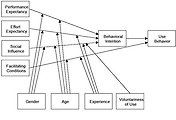
From Wikipedia, the free encyclopedia
Situated learning was first proposed by Jean Lave and Etienne Wenger as a model of learning in a Community of practice. At its simplest, Situated Learning is learning that takes place in the same context in which it is applied. Lave and Wenger (1991) argue that learning should not be viewed as simply the transmission of abstract and decontextualised knowledge from one individual to another, but a social process whereby knowledge is co-constructed; they suggest that such learning is situated in a specific context and embedded within a particular social and physical environment.
Lave and Wenger assert that situated learning "is not an educational form, much less a pedagogical strategy" (1991, p.40). However, since their writing, others have advocated different pedagogies that include situated activity:
- Workshops, kitchens, greenhouses and gardens used as classrooms
- Stand-up role playing in the real world setting, including most military training (much of which, though, takes abehaviorist approach)
- Field trips including archaeological digs and participant-observer studies in an alien culture
- On the job training including apprenticeship and Cooperative education
- Sports practice and music practice and art are situated learning by definition, as the exact actions in the real setting are those of practice - with the same equipment or instruments
Many of the original examples from Lave and Wenger (1991) concerned adult learners, and situated learning still has a particular resonance for adult education. For example, Hansman (Kimble and Hildreth 2008) shows how adult learners discover, shape, and make explicit their own knowledge through situated learning within a community of practice. A number of similar examples can be found in the ERIC digests[1] (See references below for some specific examples of this).
Contents[hide] |
[edit]Notes
[edit]See also
- Cognitive apprenticeship
- Communities of practice
- Educational technology
- Instructional design
- Situated cognition
- Transformative learning
[edit]References
- Jean Lave and Etienne Wenger (1991) Situated Learning. Legitimate peripheral participation, Cambridge: University of Cambridge Press
- Chris Kimble and Paul Hildreth (2008). Communities of Practice: Creating Learning Environments for Educators. Information Age Publishing. ISBN 1593118635.
- Situated Learning in Adult Education. ERIC Digest.
- New Ways of Learning in the Workplace. ERIC Digest.
[edit]External links
- The Odyssey of Ph.D. Students Becoming a Community of Practice
- Probationary Constables and their journey through a community of practice
- Learning Inquiry: an academic journal centered on learning
- Leonard Low and Margaret O'Connell (2006) Learner-Centric Design of Digital Mobile Learning Brisbane: Queensland University of Technology
- Foulger, T.S. (2005). Innovating Professional Development Standards: A Shift to Utilize Communities of Practice. Essays in Education, 14. Retrieved Nov 11, 2007, from http://www.usca.edu/essays/vol14summer2005.html
'Theory and Practice of Leadership > 1.Learning' 카테고리의 다른 글
| Models of Participation (0) | 2009.03.25 |
|---|---|
| Euler's Bridge, Euler's Eye & History of Internet. (0) | 2009.03.25 |
| Virtual Organizations as Sociotechnical Systems (VOSS) (0) | 2009.03.25 |
| Flow (Mihaly Csikszentmihalyi) (1) | 2009.03.25 |
| Unified Theory of Acceptance and Use of Technology (2) | 2009.03.25 |




댓글